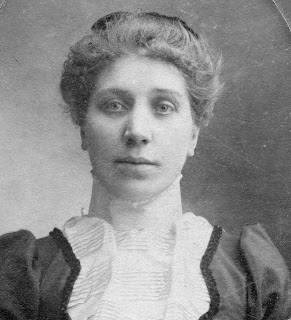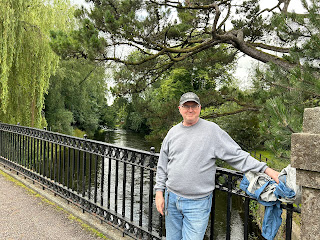Today I'd like to focus a bit on my father's maternal grandparents, in other words the parents of my Grandma Nellie. This should have been, could have been a long discussion, for when Nellie's mother, Mary Elizabeth White, died in 1956, her obituary was full of the types of details needed to trace a family back in time.
Mary Elizabeth White – Grandma White, I've been told – was born July 23, 1878 in Albany, New York to Barney Farnham and Catherine McGuire. She married Luke White in Albany on September 19, 1899. Their first child, Grandma Nellie, whose full name was Ellen Theresa White, was born on June 25, 1900. The other children were Lillian (born September 4, 1902), Edward (born April 15, 1907), Mary (born March 8, 1911) and Kathryn (born April 17, 1913). I'm happy to say that I knew all of these kids, superficially of course. However, Grandma White died when I was about 2½ years old, so I have no recollection of her. Although it looks like the family started in the Albany area, by the time of her death Elizabeth had lived in Ilion for 45 years.
[A quick aside: the name Kathryn appears in the records with lots of different spellings. I really don't know how Aunt Kaddie spelled her name, either the name Kathryn or Kaddie. If anyone knows, please pass it on!]
Those kinds of details are real gold nuggets, providing solid evidence to build upon as we trace back through the historical records. In fact, though, the oldest record I've been able to find so far is from the 1900 national census. I've not been able to corroborate anything prior to that time, not her wedding date, birth date, or her parents. More on that a bit later.
Luke White was born on May 14, 1873 in Ireland, and he emigrated to the U.S. In 1892. In the 1900 census his occupation was recorded as a railroad track laborer, in 1910 he was a section head for the railroad, 1915 the section boss. Between those last two records the family had moved from Montgomery County to German Flatts. In 1920 he was working as a laborer in business equipment, which his obituary clarifies is that he worked for the Library Bureau. Both his daughter Nellie and her husband, Fred Johnson, also worked for the Library Bureau. This was not, as I had thought, a branch of Remington such as the typewriter company or the Rand. Rather, it was a separate company that built library and office equipment: files, desks, etc. Finally, Luke's death certificate (the information coming from his wife) says that he was a wood worker.
The death certificate raises another point of interesting inconsistency. Both it and the earliest census records say that Luke was born in Ireland, and one of the latter even specifies that he arrived in 1892. I have found a Luke White, aged 20, on the passenger list for the ship Germanica, which arrived in New York on 29 April, 1892 from Liverpool and Queenstown, Ireland. Queenstown was the old name for the port of Cobh (pronounced “cove”) in County Cork. The list says that this Luke White was from Dublin; I think we need to view that record with a bit of skepticism, as Dublin may only have been the last place he lived before emigrating and not the place where he was born. Actually, even more caution is probably needed: White is a very common surname, and the given name Luke isn't really that unusual either. That, plus the fact that the age is a little off (at that time Luke would have been just a month short of his 19th birthday, not 20) leads me to consider this record as a suggestive possibility, and not as anything solid.
Luke White died in 1928 at the age of 55. He had suffered for 14 months before finally succumbing to liver cancer. I have no picture of him, but in 1918 he registered for the draft in World War I (at the age of 44). On that document he is described as being of medium build, brown eyes, brown hair, height 5'4½” (under the tall category!). I'll bet that the signature at the bottom of the first page is his.
I don't know too much about Lillian (in picture with Grandma White outside their house at 132 West Clark Street in Ilion). She never married and suffered from ill health. I believe that I remember my dad telling me that because of her severe arthritis he would carry her from one room to another. I'm sure some of you have a better knowledge and memory of the facts; I'd love to learn what you know. The two things that stick out in my memory of Uncle Ed were that (1) he attended all of the Ilion home football games, and (2) he used to play semi-pro baseball. Mary ended up living in Watertown, where she was a clothing buyer for one of the local department stores. As I wrote those sentences, I was really hit by just how scanty my knowledge is. Please folks, help me fill in the gaps!
Luke and Elizabeth White are both buried in St. Agnes Cemetery, a small graveyard “nestled” between Route 5 and the New York Thruway just north across the Mohawk River from Ilion. As you drive up the hill to the cemetery, they're in the back in the eastern corner, where you can also find the grave of their daughter Lillian and son-in-law Fred Johnson (aka Arthur Westerlund). At the western end of the hill are the graves of their daughter Nellie, grandson Alfred, and Alfred's second wife Emma. During our visit to the Mohawk Valley in May I took a brush and water to the gravestones and was able to clear away most of the lichens that had grown on them. Emma's stone has sloughed over, I think because the cement slab on which it's set has cracked and broken, but otherwise everything looks in pretty good shape.
So for the White family, I feel like we have a fairly good handle on the basic facts from recent history, but I just haven't been able to break through from the 20th into the 19th century. Grandma White's parent's names are Barney Farnham (Farnum?) and Catherine McGuire. I can't find anyone in the greater Albany area by those names in the late 1870s. Is Barney a nickname for Bernard or something else, or just a nickname (like Butch)? I had hoped that Luke White's death certificate would provide clues on where to look for him in Ireland, but his wife didn't know where he was born, other than in Ireland, or what his parents' names were. I can find no record in the Albany newspapers for the marriage of Luke White and Mary Elizabeth Farnham in 1899. That's not too unusual for newspapers of that time, though. The Catholic Church has simply ignored my inquiry. My current hope is that their marriage license will provide some kind of breakthrough. The bride and groom are supposed to give the names of their parents, and this will have the advantage over, say, an obituary or a death certificate because Luke and Elizabeth would have provided the information themselves and not some grieving relative. I requested a copy of the license from Albany in July, and I'm checking the mail every day now in hopes that it arrives. But so far, no luck.
Thanks to Ron Johnson for copies of the photos of people in this post. I also understand that some of you are having problems adding comments to the blog. This I don't understand: the settings should allow anonymous commenters and the text should appear in-line. I'll continue to try to figure out what's wrong and hope to straightened it out. In the meantime, you can always email comments to me directly at baeus2-at-yahoo.com (substitute the @ symbol for -at-).


.jpg)






















